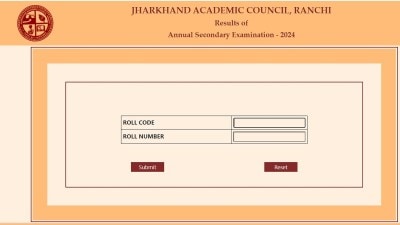- India
- International
Muzaffarnagar Muslims in classrooms of contrast
In village where Muslims have moved, pupils spill onto school’s courtyard.
 Zahid (centre, striped shirt) with his Hindu classmates ; his friend Akshay is in pale blue. ( Source: Express photo by Oinam Anand )
Zahid (centre, striped shirt) with his Hindu classmates ; his friend Akshay is in pale blue. ( Source: Express photo by Oinam Anand )Zahid is in class X at Rajakiya High School in Kutbi village of Muzaffarnagar, the only Muslim student to have returned to a class that had 36 of them last year, and which now has 110 students.
The twin villages of Kutba and Kutbi were among the worst hit by last year’s riots, with eight murders and over 50 other cases registered. None of the 200-odd Muslim families who stayed there have returned.
Zahid walks to school with 30 Hindu students from his village, Dhindawli, but has not yet dared speak with his classmates from Kutbi, especially the Jats. “I keep to myself and always sit next to Hindus from my village, especially my friend Akshay,” Zahid says. “Village students don’t talk to me and I don’t talk to them either. It’s safer that way.”
Teachers say they keep an eye open for possible fights because of Zahid since “it’s a board year”. Students say friendships, earlier defined along caste lines, have since been redefined by religion. Akshay, the topper, says he is frequently ridiculed for their friendship. “All of us were friends, but the Jats hung out with Jats, the Kurmis with Kurmis, the Dheemers with Dheemers. But now when Zahid does poorly in a test and the teacher tells me to help him, they jeer,” he says.
The Jat boys say it was silly of Zahid to have returned. “Many of our brothers and uncles are in jail, others have cases on them and have been shamed because of false complaints filed by Muslims. If we had to kill them, why would we have stayed together all these years?” says Mahender, a student.
Out of one village…

At Kutbi’s government primary, junior high and high schools, not one other Muslim student has returned, including those from neighbouring villages. At the boys’ junior high school in Kutbi, the number of students has fallen from 104 to 51; at the girls’ school, it has fallen from 50 to 34. In one primary school, the count has dropped from 80 to 47, and in another, from 75 to 38. Teachers say the four government schools and single private school in Kutbi have together lost at least 200 Muslim students. In neighbouring Kankra, which suffered ripple effects of the violence in Kutba-Kutbi, primary school one has lost 150 students, primary school two 125, the high school 50, and the junior high school 50.
Kutbi’s primary school 2, the one with 47 students, has two of its four rooms empty, with one of the two in use accommodating students of four classes — anganwadi, I, II, and III — and the other one those of IV and V. “The dropout numbers have never been so high in any year and are obviously a result of the riots,” says principal Manga Singh, a Jat. “Muslims and Jats were among our best students. We are sad because we had nurtured them and they have taken admission to other schools. They did not even come to take their transfer certificates, so we could not try and counsel the parents.”
The state government runs a competition, Medhavi Chhatra Pratayogita, for students of classes II to VIII in government schools. “ We were preparing three Muslim and two Jat students,” says teacher Vichitra Kumar, also a Jat. “But the exams were in February, when the village was still reeling under the impact of the riots. Classes had stopped, so we did not get to send any student.”
… and Into another
It is at Basi Kalan, less than 5 kilometres away, that most of the displaced Muslim families staying in a new colony have admitted their children. In the single primary school, the student strength has shot up from 280 last year to 453. Of the six rooms in the school, two are occupied by PAC personnel, so students of class II study in the courtyard. The school has done away with its 30 sections and packs students of any one class together. It has only four teachers.
“We have written to district authorities that our numbers have increased and we need more space and teachers, but there has been no response,” says Mohammad Wajid, the principal. “One teacher has to manage two classes, and look at the numbers — class III alone has 138 students.”
Wajid says until last year, teachers would do weekly rounds of the village encouraging parents to send children to school. “As an immediate effect, attendance would always shoot up, but now we dare not take such a step. Even if 40-50 students don’t come, there is a sense of relief because there is such a dearth of space,” he says.
Aman is in class III, having topped class II. She did not see the riots but has heard of them from her classmates. “I wanted to be a doctor earlier, but now I want to be a lawyer. My friend Sanya says if they had a lawyer, by now they would have got justice, but they only have a government lawyer.”
Principal Wajid says he mentions the riots and the need for communal harmony in the morning prayers. “Children see and hear things others do not, and there will always be queries. We can’t wait for the syllabus to address these, so it’s best to tell them these stories during the prayers,” he says.
Making The choice
Zahid tried to get admission in the Islamiya Madarsa in Basi Kalan, which is a Muslim-majority village, but was told they only take students up to class IX. “I have already failed a year and lost about three months of studies last year, so my father insisted I resume studies immediately,” he says.
Zahid’s father Mohammad Iliyas, a carpenter, has sought work in Kutbi as a contractor to build the midday meal kitchens in all the village’s government schools. “I don’t want my son to study in a madarsa, so to make him feel safer I have started coming with him,” he says.
In Kawal, where the violence had started after the alleged molestation of two Jat girls while they were returning from their school in Nagla Mandaur, a Hindu-majority area, the 30 Muslim students have quit. The girls, who lost two of their cousins, have returned to school, one in class X and the other in XII. The younger one says, “The Muslims killed my brothers and I don’t feel anything for them, but I don’t see why they had to leave school. I didn’t quit even after what I faced.”
Apr 19: Latest News
- 01
- 02
- 03
- 04
- 05






































